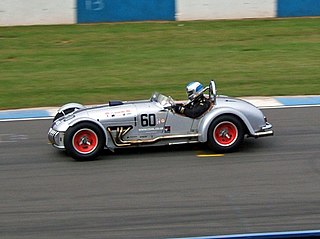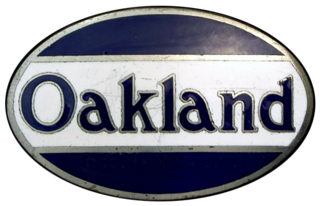
Bristol Cars was a British Manufacturer of hand-built luxury cars headquartered in Bristol, England. It was formed from the car division of the Bristol Aeroplane Company after the Second World War and later became independent as Bristol Cars Limited. After being placed in receivership and being taken over in 2011, it entered liquidation in February 2020.

The AC Cobra, sold in the United States as the Shelby Cobra and AC Shelby Cobra, is a sports car manufactured by British company AC Cars, with a Ford V8 engine. It was produced intermittently in both the United Kingdom and later the United States since 1962.

Nash Motors Company was an American automobile manufacturer based in Kenosha, Wisconsin from 1916 until 1937. From 1937 through 1954, Nash Motors was the automotive division of the Nash-Kelvinator Corporation. As sales of smaller firms declined after 1950 in the wake of the domestic Big Three automakers’ advantages in production, distribution, and revenue, Nash merged with Hudson Motors to form American Motors Corporation (AMC). Nash automobile production continued from 1954 through 1957 under AMC.

Allard Motor Company Limited was a London-based low-volume car manufacturer founded in 1945 by Sydney Allard in small premises in Clapham, south-west London. Car manufacture almost ceased within a decade. It produced approximately 1900 cars before it became insolvent and ceased trading in 1958. Before the war, Allard supplied some replicas of a Bugatti-tailed special of his own design from Adlards Motors in Putney.

Earl William "Madman" Muntz was an American businessman and engineer who sold and promoted cars and consumer electronics in the United States from the 1930s until his death in 1987. He was a pioneer in television commercials with his oddball "Madman" persona; an alter ego who generated publicity with his unusual costumes, stunts, and outrageous claims. Muntz also pioneered car stereos by creating the Muntz Stereo-Pak, better known as the 4-track cartridge, a predecessor to the 8-track cartridge developed by Lear Industries.

Crosley was a small, independent American manufacturer of subcompact cars, bordering on microcars. At first called the Crosley Corporation and later Crosley Motors Incorporated, the Cincinnati, Ohio, firm was active from 1939 to 1952, interrupted by World War II production. Their station wagons were the most popular model, but also offered were sedans, pickups, convertibles, a sports car, and even a tiny jeep-like vehicle. For export, the cars were badged Crosmobile.

Jensen Motors Limited was a British manufacturer of sports cars and commercial vehicles in West Bromwich, England. Brothers Alan and Richard Jensen gave the new name, Jensen Motors Limited, to the commercial body and sports car body making business of W J Smith & Sons Limited in 1934. It ceased trading in 1976. Though trading resumed in 1998, Jensen Motors Limited was dissolved in 2011.
Frank Peter Kurtis was an American racing car designer. He designed and built midget cars, quarter-midgets, sports cars, sprint cars, Indy cars, and Formula One cars. He was the founder of Kurtis Kraft.

Alvis Car and Engineering Company Ltd was a British manufacturing company in Coventry from 1919 to 1967. In addition to automobiles designed for the civilian market, the company also produced racing cars, aircraft engines, armoured cars and other armoured fighting vehicles.

Lea-Francis was a British motor manufacturing company that began by building bicycles.

Kurtis Kraft was an American designer and builder of race cars. The company built midget cars, quartermidgets, sports cars, sprint cars, Bonneville cars, and USAC Championship cars. It was founded by Frank Kurtis when he built his own midget car chassis in the late 1930s.

The Nash-Healey is a three-seat luxury sports car or grand tourer produced from 1951 to 1954. It was marketed by the Nash-Kelvinator conglomerate in North America as a halo car to promote sales of its Nash Motors division.

The Oakland Motor Car Company of Pontiac, Michigan, was an American automobile manufacturer and division of General Motors. Purchased by General Motors in 1909, the company continued to produce modestly priced automobiles until 1931 when the brand was dropped in favor of the division's Pontiac make.

The Boss 429 Mustang is a high-performance Ford Mustang variant that was offered by Ford in 1969 and 1970.

In 2015 Spain produced 2.7 million cars which made it the 8th largest automobile producer country in the world and the 2nd largest car manufacturer in Europe after Germany a position in the ranking that it was still keeping in 2024. Approximately 80% of that production is for export. During the first half of 2016, with exports valued over 24 billion euros over that period, the automotive industry accounted for 18.9% of the total Spanish exports.
Justice brothers were figures in motorsports and automotive industry. Founding a company in the oil additive industry.

The 1950s were pivotal for the American automobile industry. The post-World War II era brought a wide range of new technologies to the automobile consumer, and a host of problems for the independent automobile manufacturers. The industry was maturing in an era of rapid technological change; mass production and the benefits from economies of scale led to innovative designs and greater profits, but stiff competition between the automakers. By the end of the decade, the industry had reshaped itself into the Big Three, Studebaker, and AMC. The age of small independent automakers was nearly over, as most of them either consolidated or went out of business.

The Allard J2 is a sports roadster that was made by Allard. The J2 was mainly intended for the American market. Since 1981, replicas of the later J2X have been manufactured by a succession of companies in Canada, whilst a continuation of the original models is also now being produced in the UK.

The Muntz Jet is a two-door hardtop convertible built by the Muntz Car Company in the United States between approximately 1949 and 1954. It is sometimes credited as the first personal luxury car. Developed from the Kurtis Sport Car (KSC) that was designed by Frank Kurtis, it was produced and marketed by Earl "Madman" Muntz. The car was powered by one of two V8 engines, either a 160 hp (120 kW) Cadillac engine or a 160 hp (120 kW) Lincoln engine, and it was equipped with either a General Motors Hydramatic automatic transmission or a three-speed Borg-Warner manual transmission. The Jet was streamlined, featured numerous luxury appointments, and was equipped with safety features that were not standard on most cars of its day, including a padded dashboard and seat belts.

The Kurtis Sport Car (KSC) is a two-seat, aluminum-body sports car designed by Frank Kurtis and manufactured by Kurtis Kraft in 1949 and 1950. Built with numerous components from a 1949 Ford, the KSC was built as both a production car and a kit car. It was sold at a base price of $3,495. It could cost up to $5,000 with options, which was approximately $1,000 more than the then-new Jaguar XK120.





















